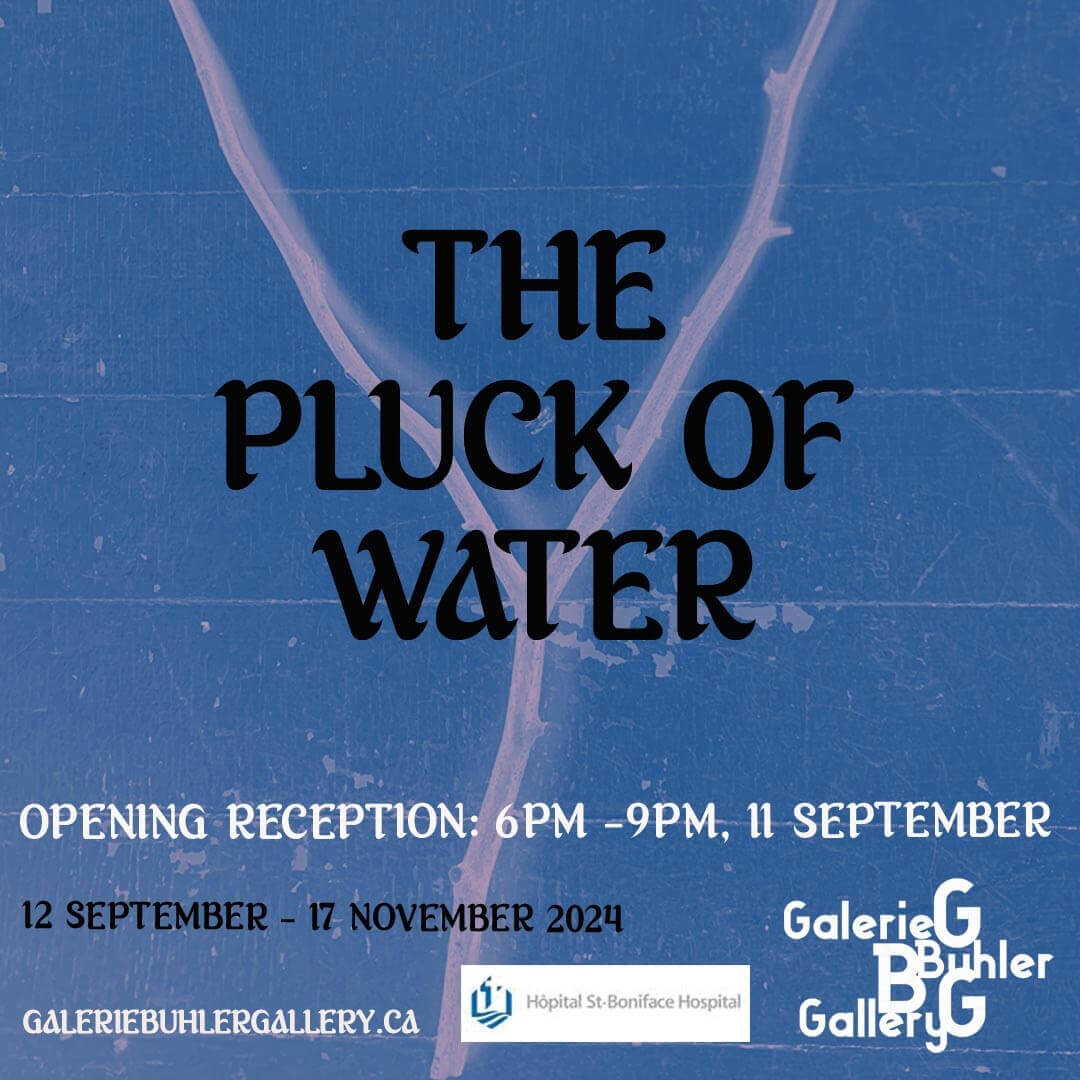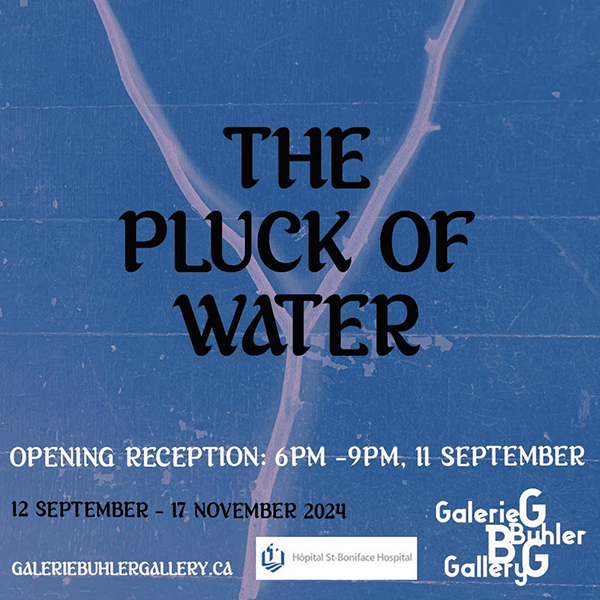The Pluck of Water

12 September – 17 November 2024
Opening reception: 6 – 9 pm, 11 September
“The pluck of water” is a phrase the Irish poet Seamus Heaney used in his poem ‘The Diviner’ to describe the sensation experienced by a man using a fork of hazel wood to detect water hidden underground. Heaney’s words also aptly describe the pull of the artworks in this exhibition, which have a kinship to divining rods bringing us to rills of meaning and connections, beauty and questions.
This is a group exhibition featuring work by KC Adams, Alexis Auréoline, Jaime Black-Morsette, Sarah Crawley, Chantal Dupas, Laila Fazal, Noëlla Gauthier, Ariel Gordon, Ted Howorth, Jennine Krauchi, Mathew Lacosse, Erika MacPherson, Tracy Peters, Chuckwudubem Ukaigwe, Katherena Vermette, and Diane Whitehouse.
Curated by hannah_g
EXHIBITION ESSAY in English
EXHIBITION ESSAY in French
More info about each individual artist’s work below.
Sarah Crawley
untitled (from the series in its path); 2020/2021.
Archival pigment on photo rag; 44” x 56”.
Sarah’s photograph evokes a strong sense of interconnectivity. It looks like a close-up of a butterfly wing with its individual scales spreading out before us, but is in fact an image of water, which reveals the ways that similar movements and patterns seem to recur among different living beings and systems. To make this work, Sarah dipped photosensitive papers two at a time, one in each hand, into Lake Winnipeg. You might be able to spot her thumb prints at the edges. These photographs are a collaboration between the artist, the sun, and the lake, all exerting a force on the paper and its chemical coating to produce a kind of portrait (maybe a self-portrait) of the lake. It’s a dreamy, psychedelic image: the patterns repeat and expand to the edges perhaps mirroring the openness we may experience when we are near bodies of water.
Tracy Peters
Stone Shadows; 2018.
Photograph of camera-less image printed on polysilk, wooden dowels, monofilament; 42” x 180”.
It is common to describe water as “catching the light” and Tracy’s piece poetically utilises this idea by capturing sunlight and water via a chemical reaction. To make this print, Tracy laid a long piece of light-sensitive lumen paper on an area of shoreline on Lake Winnipeg, covered the paper in stones, and left it twenty-four hours. The resulting image was made by the rocks, the changing sunlight, and the rise and fall of water which flowed over and under the paper and stones. Tracy then photographed the print and reproduced it life-size on a piece of polysilk, which we can see here. The original is stored in thick black plastic because it continues to change when exposed to light. The fabric reproduction will remain fixed but when someone passes by or a breeze enters through the door the material ripples and wavers as if to remind us of the image’s origin within the ebb and flow of water and sunlight.
Chuckwudubem Ukaigwe.
Time off; 2022.
Video, 01 minute 37 seconds.
In Chuckwudubem’s video installation we see three young Black men swimming and floating in an apartment building’s swimming pool. They do lengths, they bob together, they drift and we see their ease in hanging out and playing around in water. Skillfully rebuffing stereotypes of Black masculinity, the artist emphasises the swimmers’ enjoyment by presenting the footage in reverse. Doing so emphasises the water’s splashiness, removing any hint of competitiveness: they are joyful, they are gentle, they are close. The jazz soundtrack, improvised by friends of Chuckwudubem, emphasises these aspects while inviting us to share in the swimmers’ pleasure.
Ariel Gordon
Riparian Area 1; Riparian Area 2; Riparian Area 3. 2023.
Stained glass scrap, lead-free solder; 11” x 9.5” ; 7.5” x 9”; 7” x 9.5”
Mudlarking is an old pastime. Walking along river banks looking for interesting things—broken pottery, jewellery, pretty glass—it’s a pleasant way to spend time outdoors. Ariel is a mudlarker who has spent hours and hours combing an area of riverbank in Winnipeg collecting coloured glass. Many of her finds are shards of old bottles and fragments of windows and most of the pieces she works with have been shaped by the water and mud over several decades. She began making stained glass pieces with them in 2020, creating organic clusters informed by colour, hue, and shape. Ariel’s pieces have transformed glass that was once simply useful into pieces that are not-so-simply beautiful.
Chantal Dupas
Tyndall Stone Fossils Series (Cephalopod, Halysite Chain Coral, Gastropod Snail, Rugosa Horn Coral, Favosite Honeycomb Coral, Stromatoporoid Sponge Coral, Nautiloid, Receptaculite, Thalassinoides); 2024.
Graphite on paper; 5” x 8”.
From the collection of Galerie Buhler Gallery.
Tyndall limestone is evidence that Manitoba and its environs spent long periods submerged under ancient seas. Among Indigenous Peoples it is called Grandfather. This type of limestone, unique to the province, is also called Upper Mottled Limestone of the Red River Formation of the Ordovician System.
“When aquatic animals die, the shell and bones are broken down by waves … Most of the limestone layers in all parts of the earth were once shell or coral, sand and mud,” write geological researchers Kelly Snyder and Peter Russell. Among the millions of compacted sea creatures that created Tyndall stone some of their bodies have survived intact becoming fossils embedded in the rock. Chantal was commissioned by Galerie Buhler Gallery to make drawings of fossils commonly found in Tyndall stone for an identification chart that you can download from our website. Her beautiful drawings remind us that primordial seas shaped the land we live on today; they are responsible for the flatness that characterises Manitoba and we can also spot ancient sea creatures in the walls of buildings built with Tyndall stone all over the city.
Mathew Lacosse
White replacement shirt collar from Matias Kiil; 2024.
Cotton and Steel; 17.5” x 2.5” x 4”.
99% of sweat is water (the other 1% is mostly salt) and a lot of it evaporates, helping to regulate the body’s temperature. People can sweat up to three litres a day without excessive activity and our clothes are prime collectors of it. When we work, whether carrying boxes, filing papers, cleaning, caring—we sweat. Collared shirts, such as dress shirts, polo shirts, and uniforms, often identify a person as a worker whether an office clerk or delivery driver, so, when we see a collar we might see a symbol of labour with any wear and stains of perspiration acting as a record of it. This may lead us to think about the person who wore it: what did they sweat over? Were they compensated fairly? Who benefitted from their work? Did we? Mathew’s severed collars turn a familiar object—a shirt—into an abstraction creating space to think more broadly about adjacent topics, such as the changing relationship between physical bodies and labour. What do we sweat over now? The effect AI will have on our jobs? Being able to retire? What makes our labour meaningful?
Jennine Krauchi
Moss Bag, 2024.
Glass beads on fabric; approximately 22” x 13”.
Jennine is an internationally acclaimed Métis beader who has not only created original pieces but preserved and restored important artefacts, patterns, and techniques, and has significantly raised the profile of this special practice. Beading is of such importance to Métis culture and identity that they are often referred to as the Flower Beadwork People.
My Red River heritage consists of McLeod, Monkman, Spence to name a few. They settled in the community of Minnewakan close to the shores of Lake Manitoba. There, the water and land became a very important lifeline for our people.
– Jennine Krauchi
There is an important way that Métis beading is related to water. Flowers and plants—the primary subjects of the work—are an essential component of the water cycle. Plants absorb groundwater through their roots and release it back into the air through their leaves via the process of transpiration. Their contribution is enough to influence the atmosphere; a large oak tree can transpire over 150,000 litres of water a year. The flowers in the beadwork remind us that water is sacred and essential to all life.
Noëlla Gauthier.
Winnipeg, 1875, after Washington Frank Lynn; 1938.
Oil on canvas. 13.3” x 20.4”.
Collection of Le Musée de Saint-Boniface Museum, P-AA-5.
St. Boniface Hospital has strong ties to water. It is located on the Red River and overlooks The Forks. It was founded by Grey Nuns who travelled from their convent in Montreal to St. Boniface with voyageurs by canoe, an arduous two month journey along the country’s lakes and rivers. This painting of The Forks made by Noëlla Gauthier in 1938 is a copy of a painting that Washington Frank Lynn did in 1875 to commemorate the Golden Anniversary of the arrival of the Grey Nuns in St. Boniface. You can see two nuns in the bottom left corner of the painting, they are standing roughly where the Hospital stands today.
KC Adams
AsiskiyI; 2020.
Clay; 18” x 18” x 12”
The back of St. Boniface Hospital overlooks a place of great importance to many Indigenous communities: the confluence of the Red and Assiniboine Rivers–The Forks–known in Cree as Nestawaya. Since time immemorial Indigenous Peoples have met at this place to trade, participate in ceremonies, and spend time together. KC is an Anishinaabe, Inninew, and British artist who combines empirical research and blood memory in her work with clay. KC harvests and processes the clay, often from local sources, to make pots, which she fires herself.
Water flows over rocks, breaking them down into tiny particles that are carried away by currents and eventually deposited. Over time, what remains is a bounty of clay, ready to be shaped into something magical. This piece draws inspiration from the natural processes of water and the ingenuity of my Indigenous ancestors. It reflects ancient methods: harvesting and processing the clay, building the vessel, infusing it with the vapour of my breath, allowing the water to evaporate and return to the atmosphere, and finally pouring water into the vessel once it has been fired on the land. The creation of this piece is deeply influenced by the water carriers of the past and the sacred waters they tended.
KC would like to acknowledge the land and waters of Treaty One Territory, from which this clay has been harvested.
Laila Fazal
Where Will You Go; 2024.
Watercolor, thread on paper. 5 (of 12) panels of 9.4” x 13.7”.
Water attracts people, animals, and plants: the whole gamut of life. Whether a heron, gladioli, or person, life often makes its home near it.
In Laila’s scroll we see tigers, a river, and the Hindu Goddess, Bonbibi, Lady of the Forest, who, in folktales, saves the Sundarbans, the largest mangrove forest on the planet. Endangered Bengal tigers live here in West Bengal, India, the only coastal mangrove tiger habitat in the world.
The Sundarbans are one of the planet’s primary carbon sinks and an important producer of oxygen as well as a significant site of transpiration contributing to the global water cycle. The tigers are apex predators in this ecosystem. Relations between the animals and local villagers are tense since the tigers regularly kill local people and they kill the tigers. One of the reasons the forest flourishes is because the tigers deter people from cutting down trees. Laila’s work shows how central water is to healthy ecosystems but how difficult it is to maintain balance when there are competing interests.
Diane Whitehouse
Three Times from Nature; 1998.
Oil paint and mixed media on canvas. 66” x 70”.
Water, or our sense of it, is characterised by movement, its ability to fill and flow, and to switch between liquid, vapour, and solid. The top of Diane’s painting contains slightly undulating green-grey lines that form a few mountainesque peaks. Below these is an area where watery movement from a sea green pool seems to flow downwards. The paint takes on the texture of a torrent (Sigrid Dahl’s insight) which seems to rush to the bottom of the picture moving over and around shapes that suggest valleys and buildings but are too abstract to be defined. The colours and lines are only suggestions of water, landscape, and architecture and this ambiguity suggests a kind of transience. Water effects so much around it, shifting objects and distorting views, and even though its own state can also alter radically it still remains, essentially, itself.
E. J. (Ted) Howorth.
See Sarah, See Sea, Sea Sarah, See Sea, See Sarah; 1980.
Silkscreen print, 21” x 35”.
From the collection of Galerie Buhler Gallery. Gift of the artist.
Seasides and beaches are often places where people gather; attracted by the sun, towels and parasols are brought to claim a spot from which to enjoy the sand and water. Maybe it’s because of this that empty beaches can seem a little sad.
In Ted’s print, we see a woman dressed in a full-sleeved, mid-calf black dress making her way towards us. She appears three times: first walking in the shallows along the shore, then looking into the water, and finally emerging from it, the angle of her body listing to one side, indicating an uneven surface. Although she is by herself and the colours are muted it is not necessarily a melancholy scene. She has the company of the shore and seems engrossed by it. Many of us have had moments like this with water: feeling its coldness, peering into it, and simply being close by can bring a very particular kind of peace.
Alexis Auréoline
Waves #1 and Waves #2; 2023.
Silver gelatin print, 8” x 10”.
Alexis’ black and white photographs of water and light are studies in contemplation and clarity. They are minimal but expansive, inviting us to be affected by the simple act of looking at the surface of water. We might wonder about his relationship with the water he chose to photograph—where was he? What did he want to record? Or perhaps we find ourselves having our own associations and recollections. And yet, the impulse to find a story is quietened by the formal qualities in the images—the lines, light, and contrasts—which make them more than representations of water and therefore easier to become submersed in. They hold a kind of boundlessness, carrying notions of impermanence and recurrence that are melancholy, profound, and exuberant all at once.
Katherena Vermette and Erika MacPherson.
This River; 2016.
Video; 19 minutes. Courtesy of the National Film Board of Canada.
Content warning: This film contains stories about missing and murdered Indigenous people. Strong language is sometimes used.
Drag The Red is a Manitoban volunteer organisation that searches Winnipeg’s Red River and its banks for missing persons. It was founded in 2014 by a group that included Kyle Kematch and MLA Bernadette Smith in response to the disappearance and murder of Tina Fontaine, an Indigenous teenager whose body was found in the Red River. Tina’s death prompted the Canadian Human Rights Commission to request a landmark inquiry into Missing and Murdered Indigenous Women and Girls in Canada.
In this documentary, Katherena Vermette, a Michif (Red River Métis) writer, reflects on the Red River as a site of violence and hope. Katherena and Kyle share their personal experiences of family members who have gone missing and the awfulness of not knowing where they are or what happened to them. They also reflect on the fortitude of those searching for missing persons with the steadfast determination to bring them home. These painful stories of loss and violence are also stories of resilience, love, work, and connection—things this documentary conveys in a uniquely beautiful way.
Erika MacPherson
you are here/we are there; 2007.
Video, 2 minutes 58. Distributed by VideoPool.
Shot along the shores of Jökulsá á Brú, the largest glacial river in eastern Iceland, this film bears witness to a landscape being submerged under fifty-seven square kilometers of water, a reservoir created for the purpose of providing hydroelectric energy to a nearby Alcoa aluminium smelter. Images of the sublime Icelandic highland wilderness, remote hills, and the river valley fill the viewer with a powerful sense of place and lingering questions of responsibility, inter- connectedness and loss.
(Videopool Distribution).
At one point in Erika’s video we see a group people in brightly coloured rain jackets gathered by the river, holding hands, and singing. Erika has noted, “It’s an Icelandic lullaby that speaks to the land, to the nature they are tied to for better or for worse.” Translated into English, the lyrics include:
Hardship will teach you soon
While the day becomes night,
That the people love, lose, cry, and mourn.
(With thanks to Erika MacPherson for sharing the lullaby and her interpretation).
Jaime Black-Morsette
Trace; 2024.
Printed digital photograph.
Jaime is an artist of mixed Anishinaabe and Finnish descent who works with the body and land as sources of cultural and spiritual knowledge. Her photograph shows the remnant of an encounter between her and a rock in the form of a water-print. Her arms are raised as if in surrender and the intimacy of lying upon a rock naked after emerging from water would seem to involve a giving-up of self or, rather, a giving of.
The dark shapes Jamie’s body formed with the water find company in the dark dabs of moss and lichen growing on the rock’s surface as well as the shadows of the rock’s crevices, and these visual rhymes illustrate the mysterious and elegant unity between rocks, bodies, land, and water.
Follow us on Instagram: @galeriebuhlergallery

